Discover the art of perfectly smoking chicken quarters for a flavorful and juicy meal that is sure to impress.
Smoking chicken quarters is an art that combines the right temperature, timing, and technique to create a flavorful, juicy dish. This process involves selecting the best wood for smoking, preparing your chicken quarters with a delicious rub or marinade, and maintaining the perfect temperature throughout the smoking process.
This article will guide you through these crucial steps, ensuring that your smoked chicken quarters turn out perfectly every time. From selecting your chicken and wood, to preparing your smoker and serving your finished dish, you’ll find all the detailed information you need right here.
Key takeaways:
- Maintain a steady smoker temperature (225°F – 250°F)
- Use a meat thermometer to ensure internal temperature reaches 165°F
- Avoid overcrowding chicken quarters in the smoker
- Experiment with different types of wood for flavor
- Patience is key – don’t rush the smoking process
What You’ll Need for Smoking Chicken Quarters
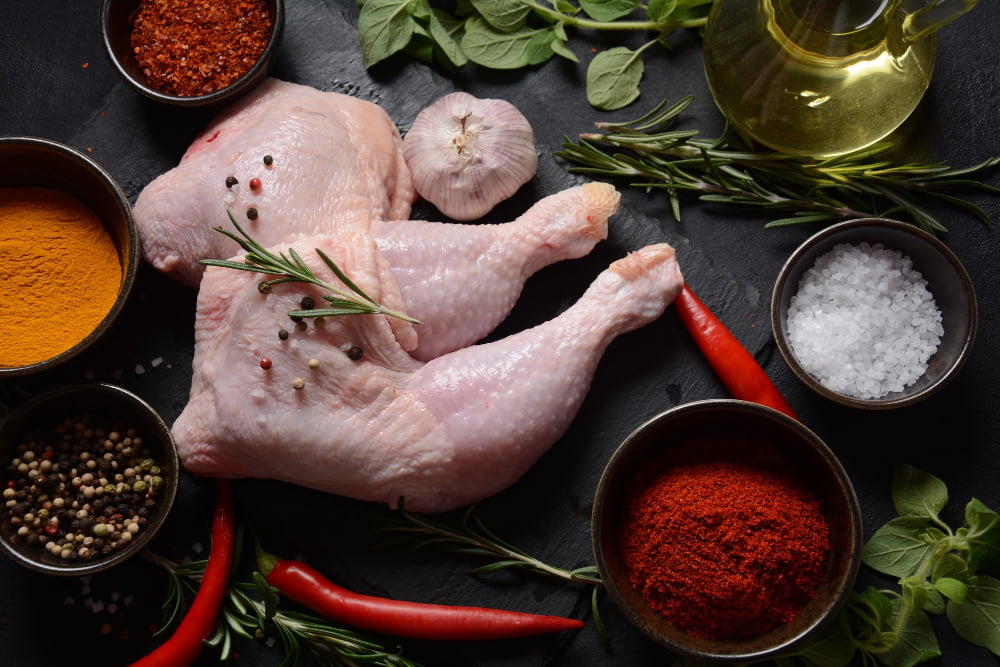
To ensure perfect results when smoking chicken quarters, having a few key items at your disposal is crucial. A capacity-rich smoker is recommended, whether it’s a charcoal, propane, or electric one. Investing in a reliable meat thermometer will take the guesswork out of determining if the chicken is fully cooked.
A collection of your favorite spices and herbs, or your chosen recipe’s suggested seasoning mix, is another crucial element. This may include salt, pepper, paprika, garlic powder, onion powder, dried thyme. A selection of wood chips for that extra layer of flavor is also essential – hickory and apple are both fantastic choices for poultry.
A spray bottle filled with apple juice or apple cider vinegar will help keep the chicken moist throughout the smoking process. Aluminum foil and a sturdy set of grill tongs will streamline the smoking process, making it easy to handle and protect your delicious smoked chicken.
Lastly, set aside adequate time. Smoking is a slow-cooking technique and rushing things will only result in subpar chicken quarters. Patience and preparation are key to the perfect smoked chicken quarters.
Ingredients You’ll Need to Smoke Chicken Quarters
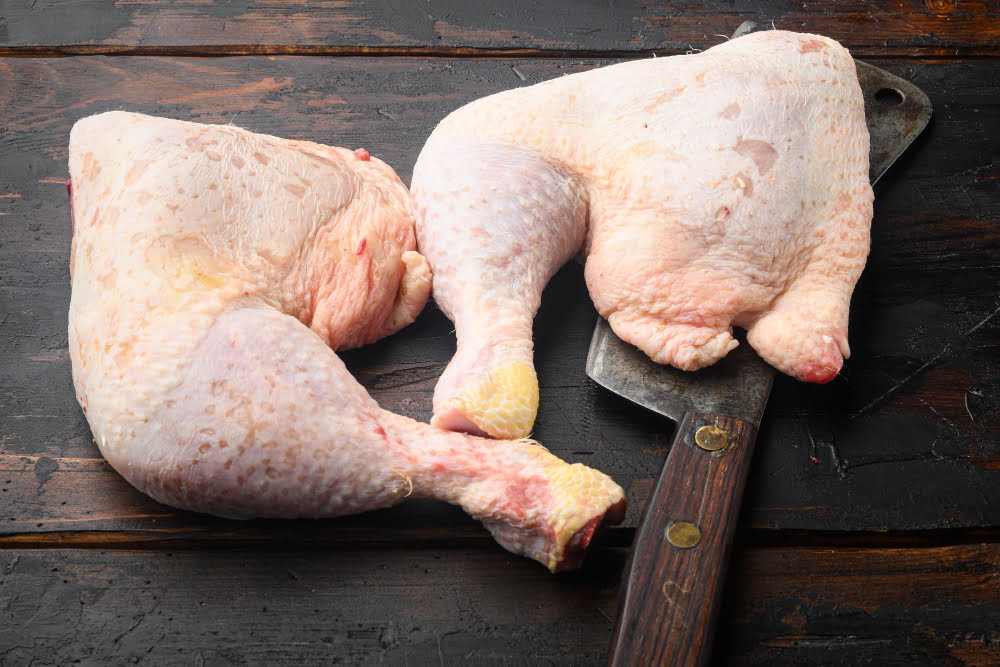
To embark on your smoking adventure, gather the following essentials:
- Chicken Quarters: The star ingredient, chicken leg quarters comprise the drumstick, thigh, and part of the back. They’re rich in flavor and don’t dry out as easily, making them ideal for smoking.
- Wood Chips: Apple, hickory, or mesquite wood chips are commonly used for smoking chicken. The choice will boil down to personal preference as each imparts a different flavor profile.
- Seasoning: Prepare your own chicken seasoning, typically a mix of salt, paprika, onion powder, garlic powder, black pepper, cayenne pepper, and brown sugar. Some also add a hint of thyme, rosemary, or oregano for an extra punch of flavor.
- Olive Oil: A healthy option for helping seasonings adhere to chicken skin, enhancing flavor, and promoting a crispy exterior.
- Brine/Injection (optional): While not a necessity, a basic brine or injection can enhance the flavor and juiciness of the chicken. Common options may include salt, sugar, water, and various herbs and spices.
- Aluminum Foil: It’s used to create a barrier during the smoking process to prevent the chicken from burning, and also to cover and rest the chicken after smoking.
- Thermometer: An essential tool to check the internal temperature of the chicken, ensuring it is cooked safely without drying out. The target temperature for smoked chicken quarters is 165°F (74°C).
- Grill Gloves: They provide protection when working with hot grates or when handling cooked chicken.
Prepare these ingredients and tools to ensure the process of smoking chicken quarters runs smoothly.
Should You Brine Chicken Before Smoking?
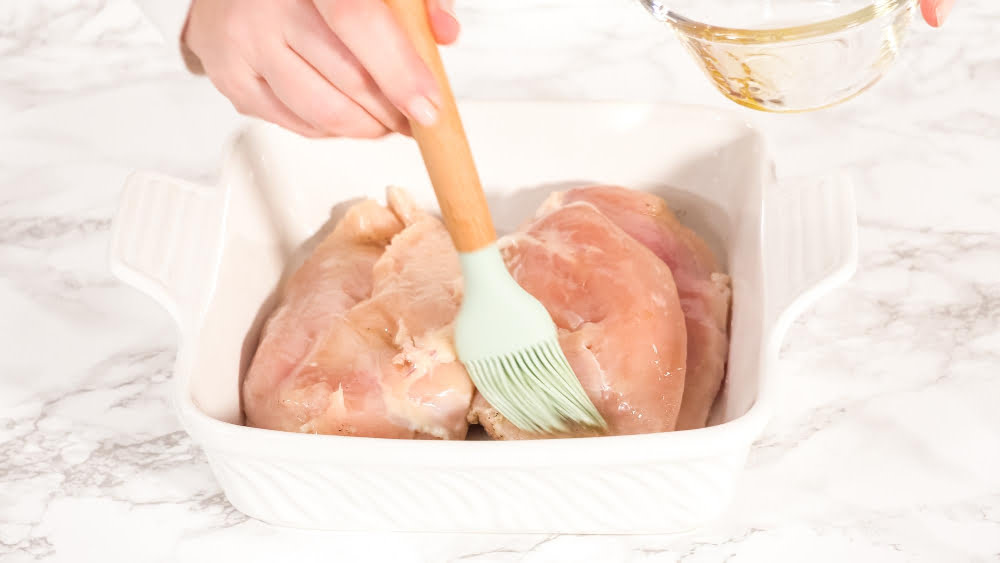
Brining has remarkable benefits for chicken. It retains moisture, enhances flavor, and tenderizes the meat, all of which are desirable characteristics when smoking chicken.
Here’s the process in a nutshell:
1. Prepare a simple brine, typically a solution of water, salt, and sugar. You might add additional flavor elements like herbs, spices, or even fruit juices.
2. Submerge your chicken quarters thoroughly in this mixture.
3. Allow the poultry to soak for anywhere from 30 minutes to overnight. The exact duration depends on both the size of the chicken pieces and personal preferences in terms of taste and texture.
4. Drain and pat dry each piece before smoking. It’s vital to dry them well to ensure a good, crisp skin.
Remember not to rush this process. Brining is a passive but effective way to add great flavor to your chicken quarters. Experiment and tweak your brine recipe until you find one that best matches your taste preference. Don’t forget to discard used brine; always use a fresh batch for each smoking session.
Preparing The Smoker for Chicken Quarters

Start by cleaning the smoker for a fresh start. Remove any ash or residue that may have been left from previous smoking sessions. This ensures purity of your smoke flavor.
After this, you’ll work on setting the right temperature. For smoking chicken quarters, maintain a temperature of 275 degrees Fahrenheit. The best results come from slow cooking at a consistent heat level that isn’t too high or too low.
Next, choose your type of wood chips. Hickory or applewood are excellent choices for poultry. It’s suggested to soak your wood chips in water for about 30 minutes prior to smoking. This slows their burn rate for a longer smoking session.
Arrange the soaked wood chips in the bottom of your smoker or on top of coals if you’re using a charcoal smoker. Once the smoker reaches the appropriate temperature, it’s ready to receive the chicken quarters.
In addition, to ensure a juicy and flavorful bird, consider placing a water pan full of apple juice, beer, or any liquid of choice, at the bottom of your smoker. This keeps the environment inside the smoker moist throughout the cooking process, preventing the chicken from drying out.
Finally, remember to have a reliable meat thermometer ready. Checking the internal temperature of the chicken is crucial to ensure it’s properly cooked and safe to eat. A perfect smoke penetrates the skin, adding flavor and tenderness to your chicken quarters.
Moving forward, follow the aforementioned steps to flawlessly prepare your smoker for cooking chicken quarters.
Which Smoker Is Best for Chicken Quarters?
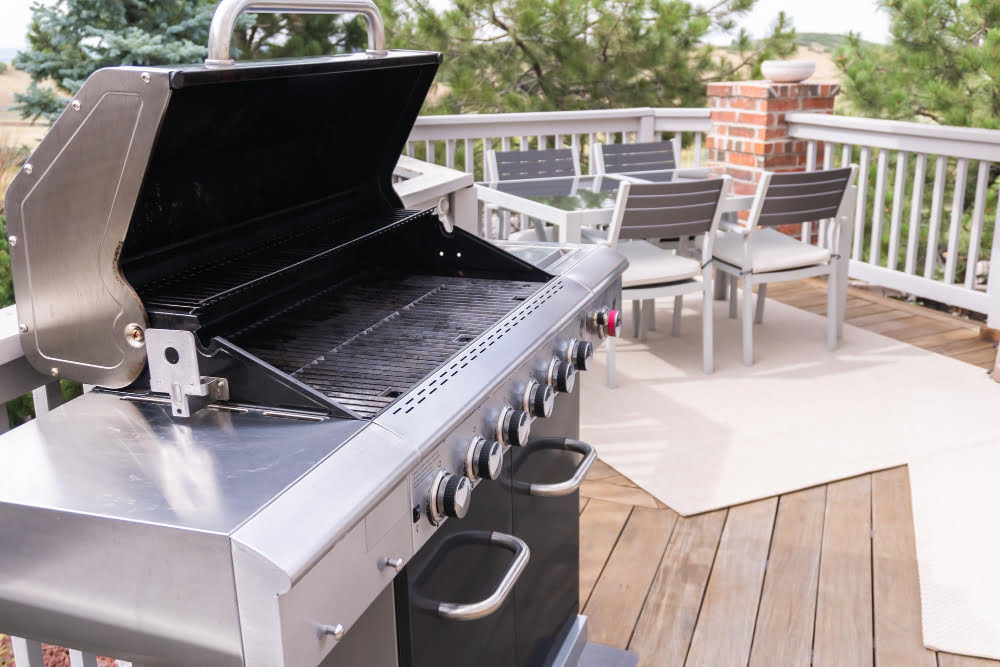
There’s a wide variety of smokers available on the market, each with its distinct advantages and features that can affect the flavor, texture, and overall quality of your smoked chicken quarters.
Offset smokers provide an authentic smoky flavor by using hardwood and charcoal. This type is particularly good at maintaining a steady temperature, which is essential for smoking poultry.
Electric smokers, on the other hand, are extremely user-friendly and require minimal attention during the smoking process. They are well-regulated and excellent at maintaining heat, ensuring your chicken quarters cook evenly.
Pellet smokers are another great option. They combine the benefits of electric smokers with the genuine wood smoke flavor. Utilizing wood pellets, these smokers provide a precise temperature control and easy usability.
Gas smokers tend to be the most convenient option, especially for beginners. They light up quickly and maintain stable temperatures throughout the cooking process.
Kamado smokers, made of ceramic or other heavy materials, are excellent at retaining heat and moisture, lending to tender, juicy chicken.
When choosing the best smoker, consider factors such as your budget, flavor preferences, time commitment, and overall cooking style. Each smoker has its unique benefits, and the most suitable one for you largely depends on your individual smoking needs and preferences.
Recommended Equipment for Smoking Chicken
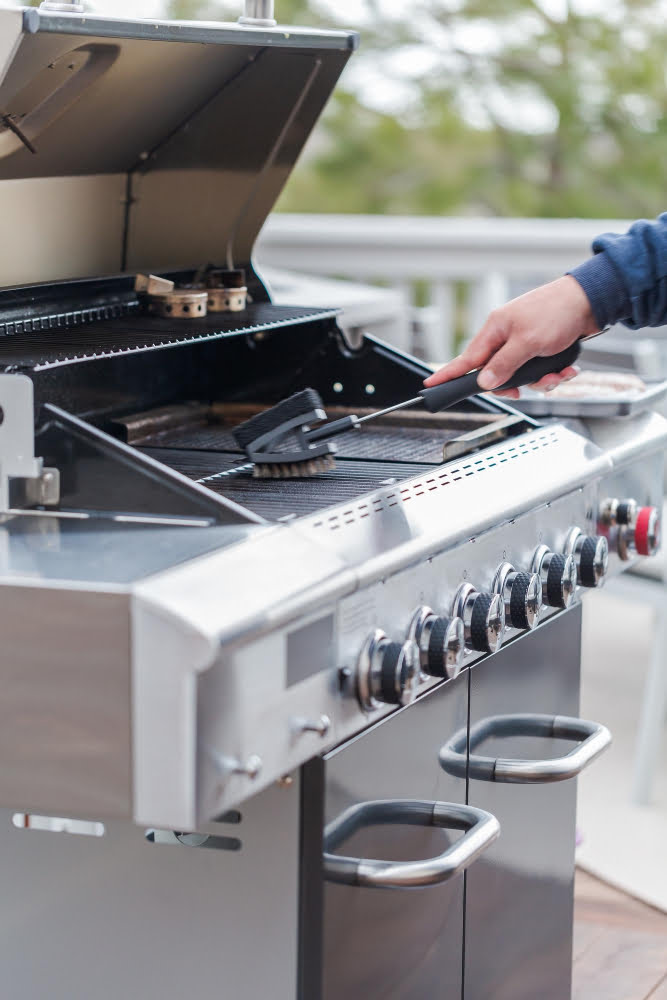
A trusty grill or smoker, of course, sits at the top of the list. Choose a model that can maintain a low, steady temperature for several hours. A pellet smoker is an excellent option as it usually offers precise temperature control.
A meat probe thermometer is essential for keeping track of the chicken’s internal temperature. This will ensure that your chicken is perfectly cooked and safe to eat.
Wood chips or wood chunks will give your chicken that distinct smoky flavor. Pecan, cherry, apple, or hickory are excellent choices to experiment with. The wood type can influence the flavor profile of your smoked chicken.
A grilling tong will allow you to handle the chicken quarters safely on the grill without burning yourself, and a sturdy grill brush will enable you to keep your grate clean, which aids in even cooking and smoke.
A drip pan or water pan can be an asset since it can catch chicken drippings, preventing flare-ups, and help maintain moisture in the smoker.
Grilling gloves aren’t a must, but they’re useful for handling hot grill grates, wood chips, and other hot objects.
Finally, a reliable chef’s knife or kitchen shears will come in handy for cutting up your chicken quarters if needed. The right cutting tool will make the job much easier and safer.
How To Smoke Chicken Leg Quarters: A Step-By-Step Guide

Start by ensuring the chicken quarters are fully thawed and have been patted dry with a paper towel. Apply a light coating of olive oil which will serve as a binder for your chosen dry rub. Work the dry rub well into the chicken, covering all areas, including under the skin where possible.
Meanwhile, preheat the smoker to around 225°F. Hardwoods such as apple, hickory, or cherry are excellent for injecting flavorful smoke into chicken. Fill up the water pan if the smoker is designed with one, maintaining the necessary moisture in the smoking chamber can prevent the chicken from drying out.
Place the chicken quarters in the smoker, skin side up. Smoking the chicken with the skin side up through the entire process helps to preserve juiciness. Arrange the quarters evenly, ensuring there is space between each quarter for the smoke to circulate effectively.
Monitor the internal temperature of your chicken quarters with a reliable meat thermometer. Aim for a final internal temperature of 165°F – the safe consumption temperature for chicken as per USDA guidelines. This process usually takes 2.5 to 3 hours, but can vary based on your specific smoker and the size of the chicken quarters.
Remember to avoid opening the smoker unnecessarily, to keep a constant temperature and smoke level. Once your chicken quarters have reached the desired internal temperature, remove them from the smoker, letting them rest for a few minutes before serving.
During the rest period, the juices redistribute throughout the meat, resulting in a moist and tender smoked chicken quarter. When done right, the outside has a golden-brown color, the meat is juicy and the flavor is richly smoky with the hint of your chosen dry rub.
Optimal Smoking Time for Chicken Quarters
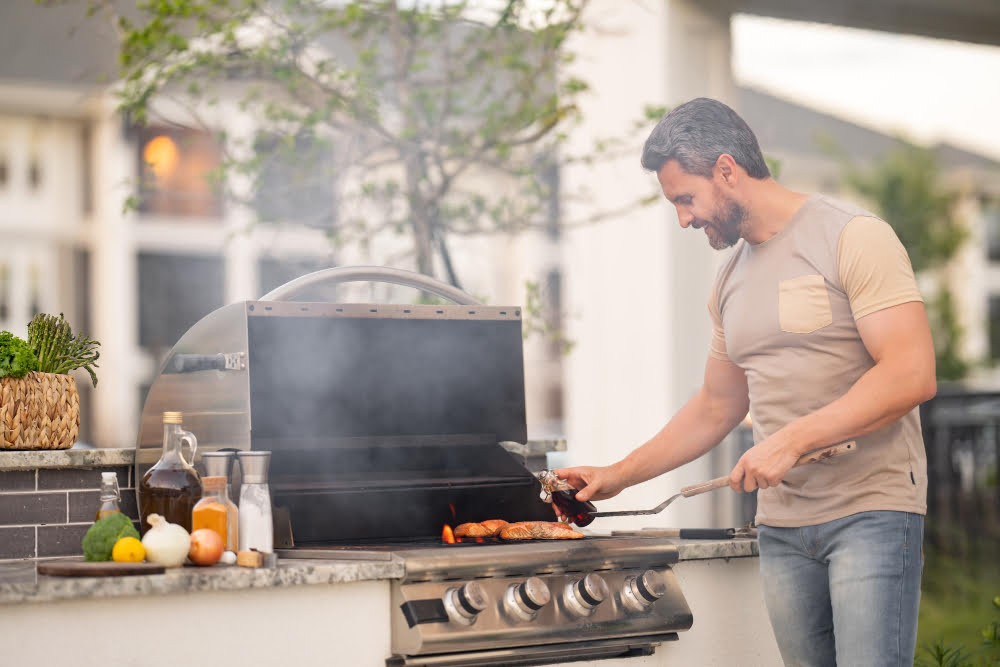
Achieving the optimal result when smoking chicken quarters largely relies on maintaining the correct temperature and smoking duration. It is crucial to keep a steady smoker temperature, ideally between 225°F to 250°F.
To check for doneness, it’s best to utilize a meat thermometer. The goal is to reach an internal temperature of 165°F on the chicken, as recommended by the USDA for safe poultry consumption.
The chicken quarters, depending on their size, should generally take around 2-3 hours to smoke at the mentioned temperature range. Make sure to monitor the smoker and chicken temperature regularly to assure a perfectly smoked chicken quarter.
Remember:
- Maintain a steady smoker temperature (225°F – 250°F)
- Aim to reach an internal temperature of 165°F
- Expect a smoking duration of 2-3 hours
- Regularly monitor both smoker and chicken temperatures.
Expert Tips for Smoking Chicken Quarters
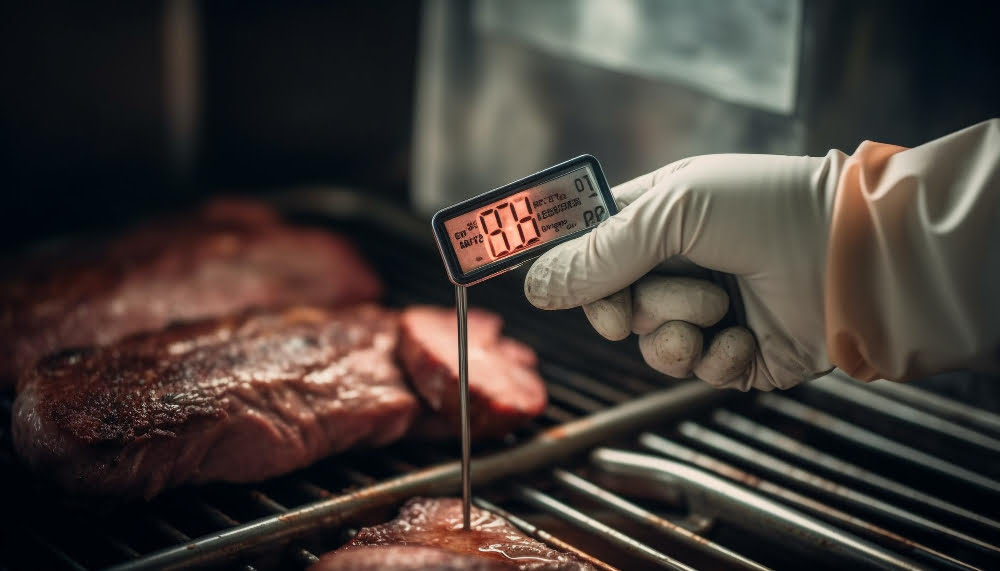
Maintaining a steady temperature in the smoker is pivotal, ideally around 275°F. Unlike other meats, chicken doesn’t require extremely low and slow smoking.
Use a meat thermometer to ensure that your chicken reaches a safe internal temperature of 165°F. Insert the thermometer into the thickest part of your chicken quarter without hitting bone for an accurate reading.
Do not overcrowd your chicken quarters in the smoker. Ample airflow around each piece ensures even cooking and proper smoke penetration.
Experiment with different types of smoking woods to influence the taste. Hickory, maple, and applewood are popular choices, each imparting a unique flavor.
Drawing designs on the chicken skin using a sharp knife does more than just create an attractive appearance. It also helps the smoke infiltrate the meat more deeply.
Basting or mopping your chicken quarters during smoking can lock in moisture and add some additional flavor. But beware, every time you open your smoker, you’re losing heat and smoke, which can lengthen the total cook time.
Creating variations in flavor is possible by adding herbs and spices to the water in the smoker’s water pan. These aromatics will infuse the meat as the water evaporates during smoking.
Wrapping chicken quarters in foil partway through the smoke can help prevent them from drying out. But this method, known as the Texas Crutch, can result in softer, less crispy skin. We recommend this for those who prefer juicier meat over crispier skin.
Learning how to control flare-ups is crucial. Keep a spray bottle of water handy to tame any flames that get out of hand. Smoked chicken should be cooked low and slow, not charred.
Remember, patience is required when smoking. Avoid constant checking or turning. For the best result, leave the smoker closed and let it do its job.
Smoking Chicken Leg Quarters: Recipe Notes
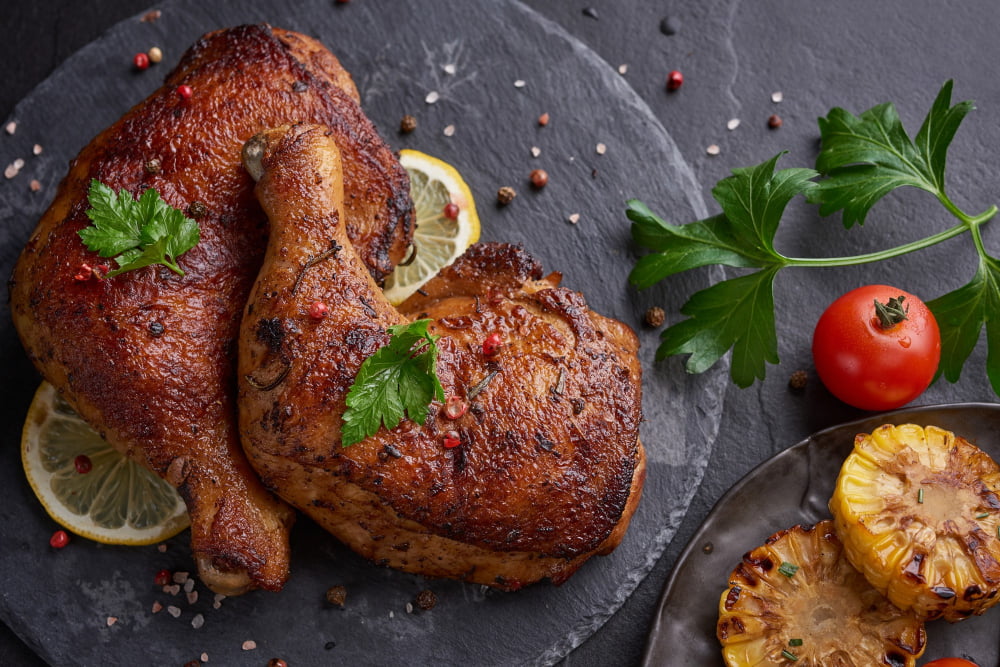
While smoking chicken quarters can seem intimidating at first, it’s actually straightforward when broken down into key steps.
Firstly, remember that maintaining a consistent temperature in your smoker is crucial. For chicken quarters, aiming for a temperature of around 225 to 250 degrees F is ideal.
Secondly, it’s important to keep the chicken quarters away from direct heat in your smoker to prevent them from burning. Use indirect heat to ensure even cooking which results in juicy, smoked chicken quarters.
Also, make rotating your chicken quarters a habit during the smoking process, usually every hour, to ensure an evenly smoked result.
Moreover, seasoning not only flavors the meat but also helps to create a desirable crust on the chicken quarters. Opt for a dry rub, marinate overnight, or a brine if you prefer a saltier punch.
Lastly, when checking the chicken quarters for doneness, an instant-read thermometer is your best friend. Insert it into the thickest part of the chicken quarter, making sure not to hit the bone. You’re looking for a temperature of at least 165 degrees F.
Bear in mind that cooking times can vary depending on size, smoke intensity, and smoker temperature fluctuations. To sum up, patience, temperature control, rotation, seasoning, and correct measurement of doneness are key elements when smoking chicken quarters.
Dips and Sauces for Your Smoked Chicken Quarters

BBQ sauce complements smoked chicken quarters exceptionally, with its tangy, sweet, and smoky flavors enhancing the meat’s flavor. This classic pairing is easy, with most basic BBQ sauces consisting of ketchup, brown sugar, vinegar, and various spices.
Honey mustard dip is another great option. Its sweetness pairs perfectly with the rich, smoky flavor of the chicken while the tanginess of the mustard cuts through the meat’s richness.
For a twist, consider a spicy sweet chili sauce. Its heat and sweet notes add a tantalizing kick to the chicken quarters, promising a unique, delightful experience.
If you’re seeking something creamy, a garlic aioli garnished with fresh herbs like rosemary or thyme works wonders. This adds a comforting and rich flavor profile to your smoked chicken quarters.
Lastly, consider a salsa verde for a fresh, vibrant touch. Bursting with tangy flavors of tomatillos, lime, and cilantro, it introduces a bright note that balances the smokiness.
Remember, these dips and sauces can be prepared in advance and served either on the side or lightly brushed on your chicken quarters before serving. You can customize these recipes to suit your taste preferences—adding more heat, sweetness, or tanginess if desired. More importantly, the choices of dips and sauces to accompany smoked chicken quarters are vast, allowing you to explore more exciting flavor combinations.
What Goes Well With Smoked Chicken Quarters?
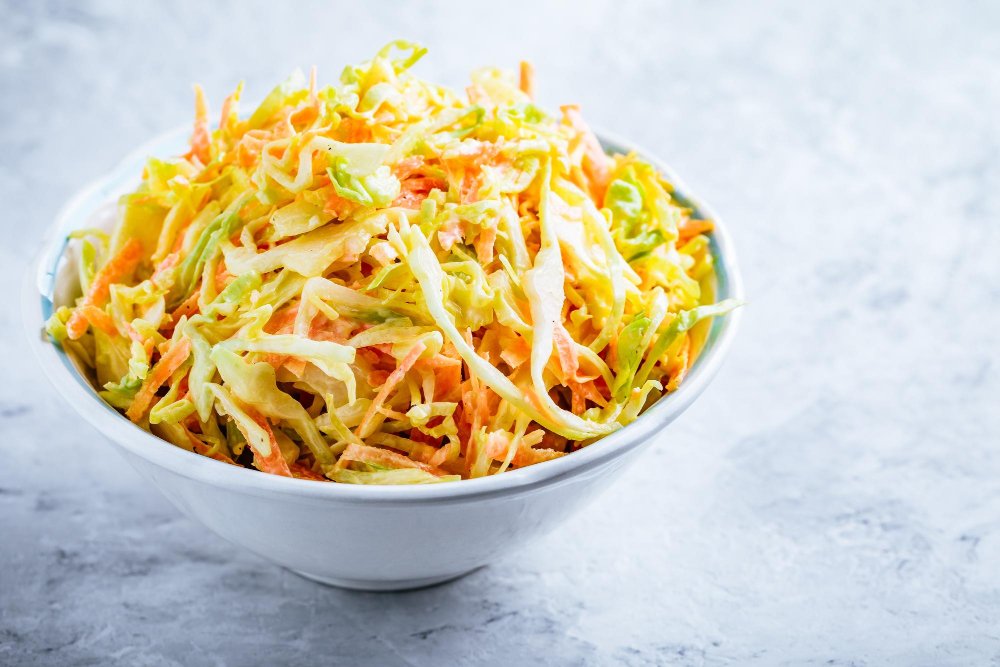
Pairing your smoked chicken quarters with complementary side dishes will heighten the dining experience. Try fresh mixed greens or a classic coleslaw to balance out the smoky flavor. Roasted vegetables, particularly root veggies like carrots or potatoes, can add a hearty refinement.
For a summer spin, consider serving with a refreshing cucumber and tomato salad. If starches are more your style, try smoked corn on the cob or creamy mashed potatoes. Baked beans, macaroni and cheese, and cornbread are other great options that deliver that well-loved comfort food feel.
As for beverages, a crisp, light beer or tart cider can cut through the richness of the smoked chicken. For wine lovers, a full-bodied, fruity red like a Shiraz or Zinfandel can partner well with the smoky meat.
To accentuate your meal, consider adding a bold BBQ sauce, a spicy salsa, or a tangy mustard dipping sauce. These finishing touches can underscore the smoky flavor and bring out the best in your smoked chicken quarters.
Serving Suggestions for Smoked Chicken Quarters
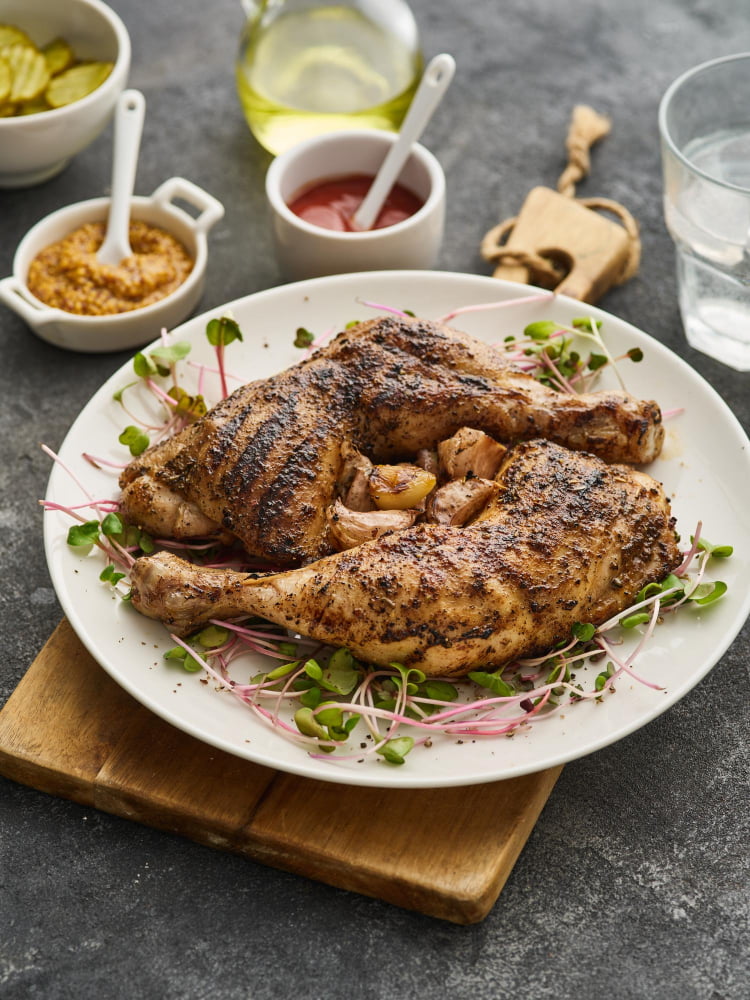
Smoked chicken quarters, with their robust flavor and tender meat, can shine in various dishes. Pair them with classic side dishes or incorporate them into more complex meals for a smoky twist:
- Serving with BBQ sides: Coleslaw, baked beans, cornbread, or potato salad are all traditional accompaniments that balance the smoky flavor.
- Incorporating into a salad: Shred the chicken and use it as a hearty addition to a salad; it pairs well with leafy greens, cherry tomatoes, crumbled blue cheese, and a tangy vinaigrette.
- Using in pastas: Smoked chicken can add depth to pasta dishes. Combine with your favorite cream sauce and noodles for a delightful meal.
- Making a gourmet sandwich: Pile the shredded smoked chicken high on a toasted roll with fresh lettuce, tomato, and a tangy BBQ sauce.
- Using in tacos or enchiladas: Add a smoky flavor to your next Taco Tuesday by using shredded smoked chicken. Top with fresh salsa, guacamole, and cheese for a delicious spin.
For lighter meals, pair smoked chicken quarters with grilled vegetables or a fresh cucumber salad. Be creative and try it with different dishes to find your favorite combination.
Proper Storage for Smoked Chicken Quarters
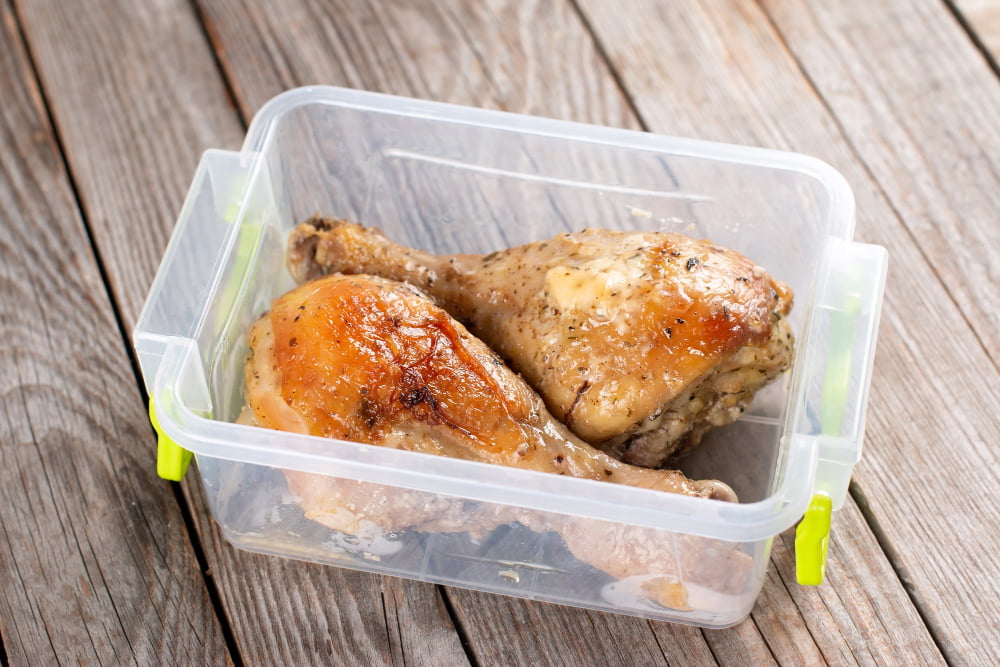
After your chicken quarters have cooled, take care to store them correctly to maintain their quality and freshness. Here are some key steps:
- Place the chicken quarters in airtight containers to prevent the meat from drying out, and to avoid any cross-contamination from other food items in the refrigerator.
- If you prefer, you can store individual servings in separate containers. This way, you only reheat what you plan to eat, preserving the rest in the fridge at a safe temperature.
- Properly stored chicken quarters can be refrigerated for up to four days.
- If you want to keep them for a longer period, consider using your freezer. Stored in the freezer, smoked chicken quarters can last up to four months.
- When freezing, wrap each quarter separately in foil or plastic wrap before placing it in a freezer bag.
- Defrosting should be done in the refrigerator overnight to ensure safe and even thawing.
Remember, no matter how delicious your smoked chicken quarters are on day one, they can still make a great meal another day if properly handled and stored.
Nutritional Information for Smoked Chicken Quarters

Smoked chicken quarters, with skin, are a dependable source of protein, offering approximately 21 grams per 3.5-ounce portion. They are also rich in essential vitamins such as vitamin B3 (niacin) and vitamin B6, which are vital for your body’s metabolism and immune system respectively.
However, keep in mind that smoked chicken quarters tend to be higher in sodium due to the seasoning and smoking process, making it important to moderate consumption if you’re watching your sodium intake.
Now, if you choose to remove the skin, you’ll save on calories and fat content. A 3.5-ounce serving of skinless smoked chicken quarters contains less fat and fewer calories, making it a healthier option.
Also, remember that your choice of seasoning and marinade influences the total calorie count and nutrition profile. Opt for herbs, spices, and low-sodium marinades to enhance flavor without adding too many additional calories or excessive sodium.
Lastly, pair your smoked chicken quarters with nutrient-dense sides like a leafy green salad, roasted vegetables, or whole grains to provide a balanced plate that aligns with dietary guidelines.
More Chicken Smoking Recipes to Try
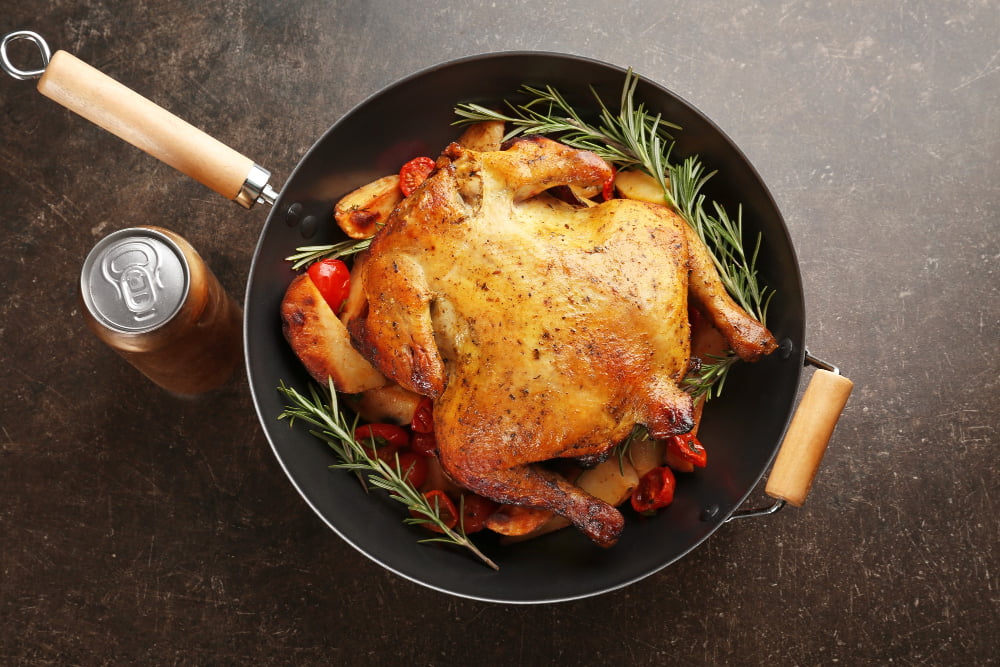
For those who’ve mastered smoking chicken quarters and want to broaden their repertoire, a variety of other flavorful chicken smoking recipes awaits to be explored:
- Smoked Whole Chicken: Slow-cooked to perfection, this bird yields juicy, flavor-packed meat and beautifully crispy skin.
- Smoked Chicken Wings: A touchdown for sports gatherings or family BBQs, these wings pack a savory punch and are even more delicious with a variety of dips.
- Beer Can Chicken: Combining two favorite pastimes – beer and BBQ – beer can chicken is stand-out juicy and subtly flavored with your beer of choice.
- Smoked Chicken Thighs: Thighs are a rich, flavorful cut of meat that’s fantastic for smoking, with a higher fat content that keeps them moist during slow cooking.
- Honey-Smoked Chicken Breasts: Lean and nutritious, these chicken breasts are infused with a sweet, smoky flavor.
- Mesquite Smoked Chicken: Mesquite chips give this chicken its strong, slightly sweet, smoky flavor, perfect for a Southwestern-inspired meal.
Each of these recipes can offer a new culinary adventure in smoking, providing a delicious and diverse range of smoked chicken dishes. Just remember the golden rule of smoking: low and slow is the way to go, to ensure your chicken is thoroughly cooked and succulent.
FAQ
How long does it take to smoke a chicken quarter?
Smoking a chicken quarter typically requires around 2 to 2.5 hours at 225°F.
How long and what temperature do you smoke chicken quarters?
Smoke chicken quarters at 250-275 degrees F for an hour to an hour and a half, or until the internal temperature reaches 180-190F.
How long does it take to smoke leg quarters at 250?
Smoking leg quarters at 250 degrees Fahrenheit takes approximately 90 minutes, aiming for an internal temperature of 165 degrees Fahrenheit as measured by a meat thermometer.
How do you smoke chicken and keep it moist?
To smoke chicken while maintaining its moisture, employ a “low and slow” cooking approach by maintaining a smoking temperature around 225°F, but not exceeding 250°F, over a prolonged period.
What type of wood is best recommended for smoking chicken quarters?
Applewood is highly recommended for smoking chicken quarters due to its mild, sweet flavor that complements poultry.
How can you tell when your smoked chicken quarters are fully cooked?
Smoked chicken quarters are fully cooked when their internal temperature reaches 165 degrees Fahrenheit, as measured by a meat thermometer.
What are some suitable marinades or rubs to use for enhancing the flavor of smoked chicken quarters?
Some suitable marinades or rubs for smoked chicken quarters include apple cider vinegar-based marinade, lemon-rosemary marinade, dry rubs with brown sugar and spices such as paprika and cayenne pepper, or a mustard-based marinade with honey and garlic.




